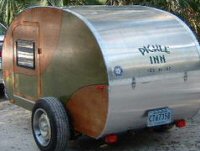I've been kicking around the idea of a tear based on the body dimensions of 5' wide, 4' tall, and 8' long. I'm looking to stay under 450 to 500 lbs total as a goal. Any chance of doing it? I was thinking about a nice solid built steel frame. Add an aluminum skeleton for the body. Either 1/4" or 1/8" birch or 1/4" luan plywood on the inside. Fully insulated. 0.040" aluminum sheeting for the outside.
I would use triangulated cross braces in the front and also at the rear bulkhead simular to what I did on the front of my first teardrop seen here.
Also the side walls would be tied together at the front and rear of the countertop by a tube of Aluminum running side to side. I imagine that this should give enough rigidity to keep the sides from racking when traveling down bumpy single tracks and washed out roads.
The aluminum body would bolt down to the steel frame. Either spring or torsion axle, not sure yet though.
If you use the figure of about 135' of tubing for an estimate I come up with the following weights:
1"x1" - 0.062" aluminum tube = 0.2729 lbs/ft = 36.84 lbs
1"x1" - 0.125" aluminum tube = 0.5132 lbs/ft = 69.28 lbs
1"x1" - 0.065" steel tube = 0.8264 lbs/ft = 111.56 lbs
I figure that I would use the heavier AL tube for the outside of the profile, the diagonal braces, the cross braces, and the door jambs. For all other horizontal stringers and verticle studs I would use the lighter AL tube. So if you split the difference then you end up with a body skeleton that would weigh in at 53.06 lbs.
The aluminum sheet weighs in at 0.58 lbs/square foot.
Figure 2 sheets 4'x8' would be another 37.12 lbs.
Figure a sheet 5'x15' to cover the front, roof, and hatch would be 43.50 lbs.
We're up to about 135 lbs.
I'm not sure what the weights for the plywood would be though. Any ideas on how to design the chassis? My thought would be to use 1.5" wide x 2.5" tall - 0.083" tube for the perimiter of the frame and maybe 1.5" x 1.5" - 0.083" for the crossmembers. 1/2" baltic birch floor. Triangulated tongue with a receiver tube for a removable tongue.
Well it's getting late and my ideas are starting to run together. I had better stop and let them collect again overnight.
Let me know what you all think.
Thanks!!
p.s. I have access to a local High School FFA group that puts out some really nice aluminum welding work. With AL I trust them to do the welding better than me.




 More to think about.
More to think about. 

